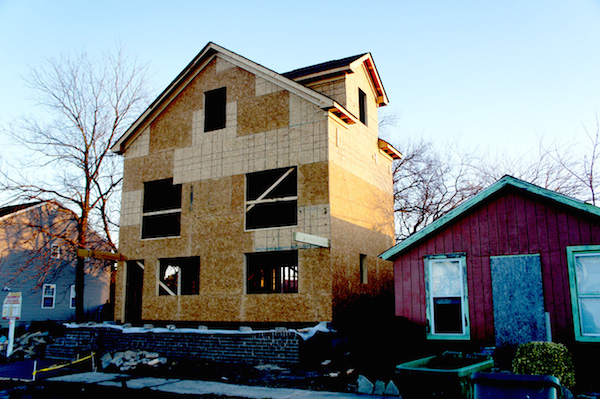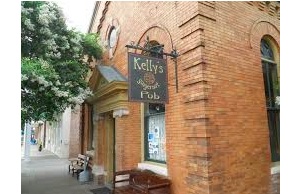WAYNE CREED Takes on the Historic Review Board

House under construction at 404 Jefferson Avenue towers over its boarded-up neighbor. The Historic District Review Board vetoed sliding glass doors on the front of the house. (Wave photo)
EDITOR’S NOTE: Last week dauntless social critic Wayne Creed attended a meeting of the Cape Charles Historic District Review Board. His report and rant appear below.
By WAYNE CREED
Cape Charles Wave
February 2, 2015
The Historic District Review Board met January 29 to consider requested modifications to the Board’s earlier approval of plans for a new home at 404 Jefferson Avenue. Owner Gregory Manuel requested permission to add a second-story covered porch on the front of the house, a dormer on the west side, sliding glass doors to access the porch, and additional stairwell windows front and back.
Chairman Joe Fehrer called the session to order at 6 p.m.; however the applicant called to say that he was delayed due to an automobile accident. In the meantime, Mr. Fehrer observed that a large dormer had already been built, and framing for the porch and sliding glass doors had also been started. Those features had never been approved by the Board, which Fehrer said was “disappointing to me.”
Moments later the applicant rushed in, out of breath. Assistant Town Clerk Amanda Hurley, who was taking notes, stopped the meeting to bring him a glass of water. Fehrer then asked him, “Why would you build a dormer outside the scope of the original approval?”
“I don’t mean to overstep my bounds,” responded Manuel. “[Code Official Jeb Brady] said to stop. We did stop when Jeb asked. I will not make a habit of it.”
Fehrer noted that dormers had been approved by the Board in other instances, yet he was skeptical in this case. “They must meet historic guidelines,” he emphasized. Jeb Brady quickly added that there are several examples of dormers throughout the town.
Relative to the second-story covered porch, Fehrer pressed the applicant to explain the necessity of the new design. Manuel stated that he wanted to provide water views, and that “It is a small house. We wanted to increase the space.”
This is the first house in town to incorporate sliding glass doors on the front (façade) of the house, prompting Fehrer to respond that they did not appear to fit in with the historic character of the town. “They are not appropriate for the Historic District. I’m loath to make an approval that will set a precedent,” he said.
Manuel then asked Code Official Brady, “There are examples of this?” He then offered the Board some alternatives that they might find more palatable, everything from adding muttons to changing the design to incorporate French doors. Punctuating the exchange, Manuel’s cell phone rang and rang, as it would several more times during the meeting.
Chairman Fehrer held that he preferred one door and one window rather than sliding or double French doors, because “it would keep it in more of the character of the town.” Manuel retorted, “Have you seen the other houses next to it? Have you seen them?” [See above photo.]
CONTINUED FROM FIRST PAGE
Eventually the Board agreed to accept a set of French doors with the requirement that one of the doors remain fixed. No real explanation was given why half the doors should be inoperable.
Moving on to the windows, Board members studied the new drawings in silence, broken only by the ringing of the applicant’s phone. It was discovered that some windows appeared on the new drawings but had been left off the staff report. “I missed it,” Brady conceded.
After another long silence, with the occasional phone ring, Board member Sandra Salopek suddenly observed, “The front stairs are on a different side!” The realization that the applicant had fundamentally changed the home’s façade from what was approved in September produced a couple of throat clearing “Ahems,” yet otherwise seemed to be taken in stride. Chairman Fehrer only noted, “Yes, it’s flipped.” Without any further questions from the Board, Fehrer addressed the applicant, holding up the new drawings. “I’m taking this on faith this is the plan you will follow.”
“I will not make a habit of [making unapproved changes],” Manuel promised. “I know better.” A motion to accept the modifications was unanimously approved.
Luckily for me, my son and I had watched a Luis Buñuel film marathon on Turner Classic Movies the previous evening, so I was prepared for the surrealism of the night’s events. Even as Mr. Fehrer bemoaned, “I’m loath to make an approval that will set a precedent,” that’s exactly what the Board did. But to be fair, they were merely following a precedent set by Town Council in the Hotel Cape Charles affair. Here’s how it works:
1) Submit plans to Historic District Review Board;
2) HDRB approves the plans;
3) Ignore approved plans and build whatever you want;
4) When caught, perform a mea culpa and beg forgiveness;
5) HDRB or Town Council feigns anger;
6) HDRB or Council approves new plans.
Outside the 404 Jefferson affair, the latest example of this is how developer J. David McCormack had approval for just 17 apartments in the old school. But now, he and consultant Paige Pollard plan to convert the school’s auditorium and stage into dormitory-style weekly rentals — that is, a hostel. And a tour of the building long promised to the Board by McCormack never happened. No, you can’t make this stuff up.
These events are disturbing on several levels. First, it is apparent that the current Board does not have a firm understanding of what their moral role is in this endeavor. The HDRB is the gatekeeper — they are the last line of defense, responsible for preserving Cape Charles’ heritage and maintaining its historical integrity. By assuming that role, they must also assume a warrior mentality, and they must approach each of these meetings from an adversarial perspective, like an Apache brave going into battle.
The default answer to each application should be an implicit DENY. Go forth from there. Let these developers and builders ultimately prove their worth, and make them earn the privilege of building in this town. If they can’t handle that, let them appeal every case to the shady antics of Town Council. If this happens enough times, and creates a living historical record, eventually some eyes will be opened to just what has been going on in Cape Charles and Northampton County for several years now.
The current HDRB does not even have the gumption to ask an applicant to turn off his phone during a meeting, so I don’t see much chance of their assuming a warrior stance anytime soon. It begs the question, if the HDRB refuses to stand up to these developers, who will?
The house on 404 Jefferson is a perfect example why an implicit DENY policy should be in place. The design, the structure itself, is trivial and irrelevant. There is nothing historical, graceful, or substantial about it. If the developer wanted to build this thing somewhere in a field out in the county, so be it. But a poor design that embraces nothing but ambivalence (even as en vogue as it apparently is at the present time) does not belong in Cape Charles. Once these things are built, it’s too late. Like the man said, a doctor can bury his mistakes, but an architect can only advise his clients to plant vines.
Taking this further, the Historic Guidelines are too limp. There needs to be a more stringent design aesthetic for new construction. New Construction should be limited to only three styles: American Four Square, Vernacular Victorian, and Vernacular (American) Gothic—all in the Cape Charles style. Any design that deviates from these three, or is deemed weak, pathetic, stupid, or insufficient, should be denied (unceremoniously).
The word has gotten out to the developers in Virginia Beach and Richmond that Cape Charles and Northampton are pushovers, easy marks — you are free to cross the bridge and just run amuck. This needs to stop here. As Castaneda said, we either make ourselves miserable, or we make ourselves strong. The amount of work is the same.
So, which is it going to be?




















I think Cape Charles should build homes as pictured beside this unofficial home (one boarded up) which would be in keeping with the Cape Charles charter!
Hmmm. And what of our 1933 Sears Modern Home Oak Park Model on beautiful Monroe Avenue? It’s a Dutch Colonial, clearly not one of the three styles Mr. Creed favors. Are we to tear down and start anew?
Wow….Try and build a house in C.C. and face bunch of Apache warriors? If I want french doors I have to have one I can’t open? I would advise anyone who entertains the idea of buying property in C.C. to do their homework. It appears that you have little choice of how to construct your own house…. let me repeat…..your own house. Your town will continue it’s downward spiral with this attitude. People with the money who want to build one of your three styles do not exist on the Eastern Shore. Bury the hatchet? Only in someone weak, stupid or pathetic enough to build in your town.
Building a new structure and renovating the exterior of a structure in The Town of Cape Charles gets complicated as the Town has been listed in the National Register of Historic Places by the United States Department of the Interior. The Town may also be involved in the Certified Local Government Program – I’m not sure.
One of the goals of the Historical Register is to create guidelines to help preserve historical structures and areas by providing financial assistance (key phrase) to participating local governments and homeowners.
The role of the Historic District Review Board as I understand it is to guide contractors and renovators in order to maintain the community character as outlined in State and local legislation.
If we don’t follow the ordinances we can lose our standing with the National Register – this makes it more difficult to qualify for the tax credits.
It all boils down to preservation and funding.
The town of Cape Charles lost its historic charm when the cookie cutter million dollar homes went up years ago…and you’re worried about sliding glass doors & dormer windows? Ha!
I live on Jefferson. I often refer to my block as the “Marina Overlook” district of Jefferson. I am so happy that Mr. Manuel is taking a chance on one of the most blighted blocks on one of the most blighted streets in town and is building a beautiful house next to a boarded up shack. Welcome to the neighborhood Mr. Manuel! I will be there to greet you with a bottle of champagne when you move in.
First, a little housecleaning…an anonymous comment seems to be extremely worried about the ‘very scary’ thinking in this article.
This character seems quite worried about the notion that ‘Cape Charles will require an investment-friendly culture to survive and thrive.’ Really? The Town created a sweetheart deal for the Shanty (although an unintended consequence may have been severely harming local business, such as Kelly’s and the now defunct ‘Aqua’ (oh, I know, it’s an oyster farm now. Please)). The town gave away the old school to a developer for $10, and has never charged him a penny for hookup fees (fees that would cost the rest of us tens of thousands of dollars). Seems like a chunk of investment went in and around all of Bay Creek (see the Brown & Root deal), didn’t it? Oh, oh, and the Hotel Cape Charles and the Yacht Center? Patrick Hand is about to create the Strawberry Street Corridor of new shops and apartments, isn’t he? From this perspective, Cape Charles does seem fairly investment friendly, wouldn’t you say?
And, the article never said the HDRB made the incorrect decision here; the original decision to approve in the first place is what’s off the chain.
You know what’s really scary? It’s talk like ‘a street which needs investment’. In other words, build it up, raise the costs, run the current residents off, raze the ‘blighted’ homes and build a bunch of vulgar, trivially delightful abodes in their place, all cozy and nice for the plastic masses to retire in. You know, gentrification (real scary if you’re not rich).
Mrs. Bauer, Mr. Manuel is only the builder. He lives across the bay, and I don’t think he has plans to move in any time soon. However, if you want to deliver him a bottle of champagne, you can probably meet him over at Kiptopeke Villages. You two can pop the cork and enjoy the view over the massive holding pond that will soon be constructed there.
While we’re house cleaning…Ms. McLaren, I think the three styles only refer to ‘New’ construction. Nobody said anything about tearing anything down, even if it did come from Sears.
Mr. Henderson, read this again. I think the point is you can do anything you want, Historic Guidelines or not. You, as an American, are free to construct your Cape Charles home as stupidly and pathetically as you so desire. You just can’t have a sliding glass door in the front.
Comrade Wayne, those Mao suits come only in three styles? Bummer. Can we at least wear them with high heels?
@Lascu, it’s not what you wear, but how you wear it. It’s all about being fabulous, isn’t it? High heels? Sorry, not pullin’ it off.
The dissonance of watching an American Marxist argue with a man who ACTUALLY lived through a communist nightmare and to see the Marxist refuse to accept the ACTUAL experience of the man who knows firsthand the Gulag Archipelago is one of the best parts of reading the Wave.